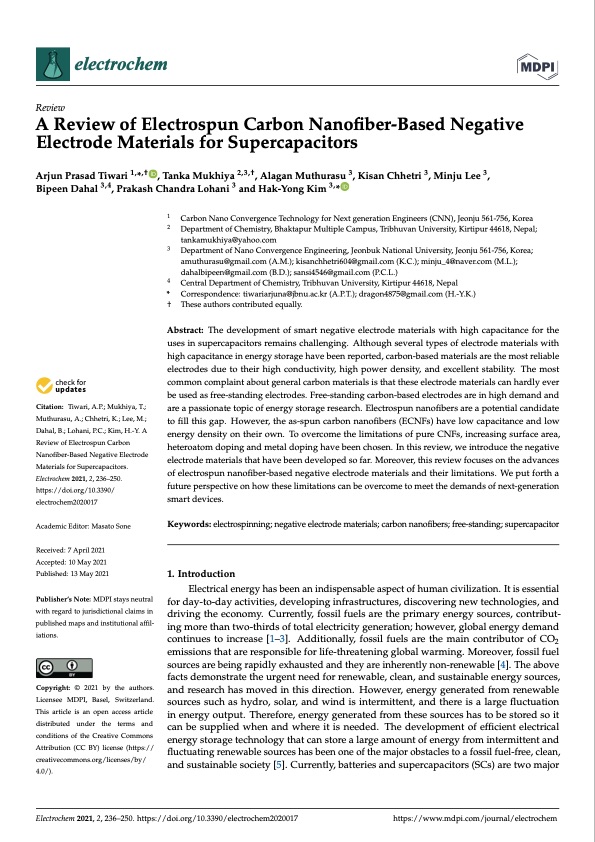
PDF Publication Title:
Text from PDF Page: 001
electrochem Review A Review of Electrospun Carbon Nanofiber-Based Negative Electrode Materials for Supercapacitors Arjun Prasad Tiwari 1,*,† , Tanka Mukhiya 2,3,†, Alagan Muthurasu 3, Kisan Chhetri 3, Minju Lee 3, Bipeen Dahal 3,4, Prakash Chandra Lohani 3 and Hak-Yong Kim 3,* Citation: Tiwari,A.P.;Mukhiya,T.; Muthurasu, A.; Chhetri, K.; Lee, M.; Dahal, B.; Lohani, P.C.; Kim, H.-Y. A Review of Electrospun Carbon Nanofiber-Based Negative Electrode Materials for Supercapacitors. Electrochem 2021, 2, 236–250. https://doi.org/10.3390/ electrochem2020017 Academic Editor: Masato Sone Received: 7 April 2021 Accepted: 10 May 2021 Published: 13 May 2021 1 2 3 4 Abstract: The development of smart negative electrode materials with high capacitance for the uses in supercapacitors remains challenging. Although several types of electrode materials with high capacitance in energy storage have been reported, carbon-based materials are the most reliable electrodes due to their high conductivity, high power density, and excellent stability. The most common complaint about general carbon materials is that these electrode materials can hardly ever be used as free-standing electrodes. Free-standing carbon-based electrodes are in high demand and are a passionate topic of energy storage research. Electrospun nanofibers are a potential candidate to fill this gap. However, the as-spun carbon nanofibers (ECNFs) have low capacitance and low energy density on their own. To overcome the limitations of pure CNFs, increasing surface area, heteroatom doping and metal doping have been chosen. In this review, we introduce the negative electrode materials that have been developed so far. Moreover, this review focuses on the advances of electrospun nanofiber-based negative electrode materials and their limitations. We put forth a future perspective on how these limitations can be overcome to meet the demands of next-generation smart devices. Keywords: electrospinning; negative electrode materials; carbon nanofibers; free-standing; supercapacitor 1. Introduction Electrical energy has been an indispensable aspect of human civilization. It is essential for day-to-day activities, developing infrastructures, discovering new technologies, and driving the economy. Currently, fossil fuels are the primary energy sources, contribut- ing more than two-thirds of total electricity generation; however, global energy demand continues to increase [1–3]. Additionally, fossil fuels are the main contributor of CO2 emissions that are responsible for life-threatening global warming. Moreover, fossil fuel sources are being rapidly exhausted and they are inherently non-renewable [4]. The above facts demonstrate the urgent need for renewable, clean, and sustainable energy sources, and research has moved in this direction. However, energy generated from renewable sources such as hydro, solar, and wind is intermittent, and there is a large fluctuation in energy output. Therefore, energy generated from these sources has to be stored so it can be supplied when and where it is needed. The development of efficient electrical energy storage technology that can store a large amount of energy from intermittent and fluctuating renewable sources has been one of the major obstacles to a fossil fuel-free, clean, and sustainable society [5]. Currently, batteries and supercapacitors (SCs) are two major Carbon Nano Convergence Technology for Next generation Engineers (CNN), Jeonju 561-756, Korea Department of Chemistry, Bhaktapur Multiple Campus, Tribhuvan University, Kirtipur 44618, Nepal; tankamukhiya@yahoo.com Department of Nano Convergence Engineering, Jeonbuk National University, Jeonju 561-756, Korea; amuthurasu@gmail.com (A.M.); kisanchhetri604@gmail.com (K.C.); minju_4@naver.com (M.L.); dahalbipeen@gmail.com (B.D.); sansi4546@gmail.com (P.C.L.) Central Department of Chemistry, Tribhuvan University, Kirtipur 44618, Nepal * Correspondence: tiwariarjuna@jbnu.ac.kr (A.P.T.); dragon4875@gmail.com (H.-Y.K.) † These authors contributed equally. Publisher’s Note: MDPI stays neutral with regard to jurisdictional claims in published maps and institutional affil- iations. Copyright: © 2021 by the authors. Licensee MDPI, Basel, Switzerland. This article is an open access article distributed under the terms and conditions of the Creative Commons Attribution (CC BY) license (https:// creativecommons.org/licenses/by/ 4.0/). Electrochem 2021, 2, 236–250. https://doi.org/10.3390/electrochem2020017 https://www.mdpi.com/journal/electrochemPDF Image | Review of Electrospun Carbon Nanofiber-Based Negative Electrode Materials

PDF Search Title:
Review of Electrospun Carbon Nanofiber-Based Negative Electrode MaterialsOriginal File Name Searched:
A_Review_of_Electrospun_Carbon_Nanofiber-Based_Neg.pdfDIY PDF Search: Google It | Yahoo | Bing
Sulfur Deposition on Carbon Nanofibers using Supercritical CO2 Sulfur Deposition on Carbon Nanofibers using Supercritical CO2. Gamma sulfur also known as mother of pearl sulfur and nacreous sulfur... More Info
CO2 Organic Rankine Cycle Experimenter Platform The supercritical CO2 phase change system is both a heat pump and organic rankine cycle which can be used for those purposes and as a supercritical extractor for advanced subcritical and supercritical extraction technology. Uses include producing nanoparticles, precious metal CO2 extraction, lithium battery recycling, and other applications... More Info
| CONTACT TEL: 608-238-6001 Email: greg@infinityturbine.com | RSS | AMP |